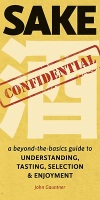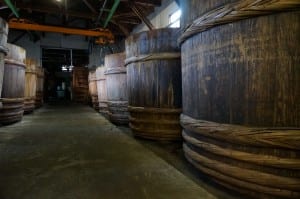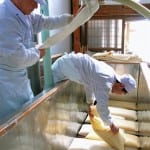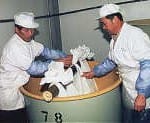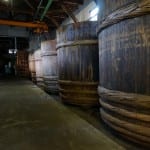Suffering does not (always) equal better sake
Sake sadists. They’re out there. You may be one of them. In truth, “sake romanticists” might be just as applicable a term, although it garners less attention. “Sake sadists” makes a better eye-grabbing headline.
To what does that refer? There are many people out there – inside Japan and out, Japanese and not, some that know their sake well and some that do not – that seem to like a sake better if they are led to believe that the brewing staff suffered more when brewing it.
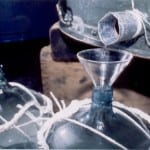 Let’s sake that two glasses of sake were put before someone of this bent. And let us say that for the one on the right, he or she was told that, in order to make this level of quality, the koji was made in such a labor intensive way, and with so much more attention to detail, that the toji (master brewer) had to get up every 90 minutes to check on the moisture and temperature, every day for five months of the year. (Such sake exist!) And let us tell him or her that the one on the left was made using modern equipment that accomplished the same thing, without the koji-person needing to even get out of bed.
Let’s sake that two glasses of sake were put before someone of this bent. And let us say that for the one on the right, he or she was told that, in order to make this level of quality, the koji was made in such a labor intensive way, and with so much more attention to detail, that the toji (master brewer) had to get up every 90 minutes to check on the moisture and temperature, every day for five months of the year. (Such sake exist!) And let us tell him or her that the one on the left was made using modern equipment that accomplished the same thing, without the koji-person needing to even get out of bed.
I can all but guarantee that if these two sake were placed before a sake sadist, he or she would like the one on the right. Deprival. Discomfort. Fatigue. Angst. These are sometimes mistakenly considered to be connected to craftsmanship and quality.
And in truth, sometimes they are. Very commonly the old ways do, in fact, lead to better sake. That is why they have been doing it that way for centuries upon centuries. But not always. Sometimes the ease and comfort that modern technology affords is, actually, just as good as the labor intensive ways, or even better.
Sometimes technology can in fact augment craftsmanship. Not replace it, mind you, but seriously augment it.
An example of this arose when visiting a brewery in Shimane (Ok, it was Rihaku) with a handful of visitors from the US. The president and toji-for-now was explaining how they made their koji. Let me preface this by saying that the company is now transitioning from having an old, experienced toji who could make do with a minimum of modern conveniences like thermometers and scales, and who still cranked out consistently great sake, to young staff that are far less experienced.
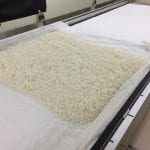 He led a dozen of us into his koji-making room. Therein, steamed rice with a mold sprinkled on it would spend 48 hours or so of pampering and tweaking, permitting the mold to grow into the rice, giving off the enzymes that will liquefy the rice, and convert its starch to sugar. Koji making: the heart of the sake brewing process.
He led a dozen of us into his koji-making room. Therein, steamed rice with a mold sprinkled on it would spend 48 hours or so of pampering and tweaking, permitting the mold to grow into the rice, giving off the enzymes that will liquefy the rice, and convert its starch to sugar. Koji making: the heart of the sake brewing process.
He tapped the thigh-high stainless steel table with the heel of his palm as he spoke. “This entire table sits on a scale. We can see the weight of the rice that sits upon it,” he explained as he pointed to a red LED display in the corner.
“Moisture content is everything in completed koji. It guides the mold, and also affects how fast things dissolve. And we know for each batch of koji precisely what we want that moisture content to be.
“And, because we know how much dry rice we started with, once we load it up here and weigh it we know what the moisture content is at that point. Naturally, that means we know how much moisture we need the rice to give up through evaporation.”
He continued, obviously pleased with his new toy.
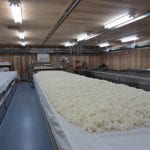 “By spreading the rice out over a larger and larger area of the table, we can create more surface area, and blow off less or more moisture, as needed. We adjust that moisture content during the first 24 hours of the koji-making process.”
“By spreading the rice out over a larger and larger area of the table, we can create more surface area, and blow off less or more moisture, as needed. We adjust that moisture content during the first 24 hours of the koji-making process.”
He walked over to the corner of the table, and showed us what is basically a ruler along the edge of the table that indicates the distance from the edge. He then showed us a large, laminated card with a graph printed on it.
“Like I said, we know what we want the moisture to be when our koji is completed. And we know what the moisture content is when the rice comes into this room. So we know how much we need it to give off. And, finally, for a given thickness of the layer of rice sitting on this table, we know how much it will blow off, the speed at which it will dry out.
“So by looking at this graph, we can see that if the rice on the table weighs X kilos, then we spread the rice out on the table as far as point Y. If that is done properly, the perfect amount of moisture will evaporate, and we will have perfect moisture in the rice as we go into the crucial second day of koji making.
“If we set it up this way, with just one experienced person in here, heck, even you guys could make good sake.” This was immediately followed by a surely unintentionally condescending snort.
“But,” he continued, “consumers these days do not want to hear that. No one wants to hear how modern technology and clever ideas makes 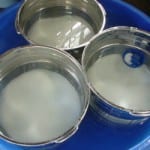 sake brewing easier. They want to hear how much effort and angst and hard work we had to do. They want to hear how we suffered to achieve that attention to detail.” He smiled wryly as he slowly shook his head.
sake brewing easier. They want to hear how much effort and angst and hard work we had to do. They want to hear how we suffered to achieve that attention to detail.” He smiled wryly as he slowly shook his head.
“Somehow, people think that the more the brewer had to suffer, the better the sake. Of course, there are steps of the process in which that is close to true. But there are also plenty of clever tricks and modern tools that make sake that is just as good, with less effort.”
He then went on (and on) about how the old toji who had retired a few years ago made do with so much less. He was able to do much of his work without entire tables on scales or graphs. He was so experienced in his craft that he was able to do almost everything by observation, experience and intuition honed through years of dedication to his craft.
Surely there are still toji like that. But not many. As the industry changes, and the brewing staff at more and more kura change from old gnarly guys from the boonies to local youths enjoying a newfound passion, impossibly accurate intuition and modern tools will continue to coexist.
And it will therefore become increasingly important to rein in “sake sadism” and even “sake romanticism”. As long as it tastes and smells good to us, it matters not how it got there.





 Several years ago, in July of 2014, the Yamagata Prefecture Sake Brewers’ Association began the process of securing a designation of their sake as a Geographical Indication recognized by the World Trade Organization and various international treaties. In order to qualify for something like this, a product (any product applying for a GI) must possess qualities or a reputation that are due to that origin. Securing such a designation gives the region and its producers the exclusive right to an appropriate indication on the label.
Several years ago, in July of 2014, the Yamagata Prefecture Sake Brewers’ Association began the process of securing a designation of their sake as a Geographical Indication recognized by the World Trade Organization and various international treaties. In order to qualify for something like this, a product (any product applying for a GI) must possess qualities or a reputation that are due to that origin. Securing such a designation gives the region and its producers the exclusive right to an appropriate indication on the label.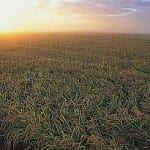 public hearing on the topic on October 19 of this year. It was not made clear how long this stage will take, but assuming it does pass smoothly, Yamagata Sake will come into existence as a bona fide Geographical Indication (GI) for sake. One more region in Japan, the city of Hakusan in Ishikawa Prefecture, has qualified for a GI for the sake of that region. However, it only applies to the five breweries in city of Hakusan; the rest of the breweries in Ishikawa Prefecture are unaffected. Yamagata Prefecture will be the first entire prefecture to secure this distinction.
public hearing on the topic on October 19 of this year. It was not made clear how long this stage will take, but assuming it does pass smoothly, Yamagata Sake will come into existence as a bona fide Geographical Indication (GI) for sake. One more region in Japan, the city of Hakusan in Ishikawa Prefecture, has qualified for a GI for the sake of that region. However, it only applies to the five breweries in city of Hakusan; the rest of the breweries in Ishikawa Prefecture are unaffected. Yamagata Prefecture will be the first entire prefecture to secure this distinction.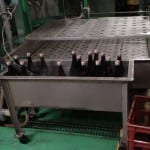 There are at present 51 sakagura brewing in Yamagata. The oldest of these dates back to the Japanese “Warring States” era of long civil war, while the youngest can trace their roots to the beginning of the Edo period. Even the new kid in town is an old and dignified character.
There are at present 51 sakagura brewing in Yamagata. The oldest of these dates back to the Japanese “Warring States” era of long civil war, while the youngest can trace their roots to the beginning of the Edo period. Even the new kid in town is an old and dignified character.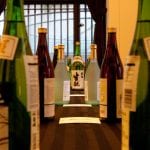 From Monday, April 3 until Wednesday April 5, I will hold the first Sake Professional Course of 2017 at Bentley Reserve in San Francisco. If interested, for more information please send me an email at sakeguy@gol.com.
From Monday, April 3 until Wednesday April 5, I will hold the first Sake Professional Course of 2017 at Bentley Reserve in San Francisco. If interested, for more information please send me an email at sakeguy@gol.com.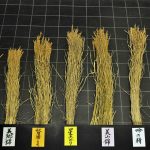 The main raw materials of sake are rice and water, and rice is the only fermentable material used in its production. And just as the grapes used to make good wine are significantly different from those bought at the supermarket, the rice used to make premium sake is significantly different from that which we find sitting under the fish in sushi, or in bowls in meals.
The main raw materials of sake are rice and water, and rice is the only fermentable material used in its production. And just as the grapes used to make good wine are significantly different from those bought at the supermarket, the rice used to make premium sake is significantly different from that which we find sitting under the fish in sushi, or in bowls in meals.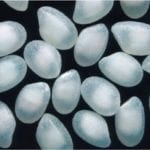 In proper sake rice, the higher-than-normal starch content is mostly concentrated in the center of the grains. Why is this so heart-warmingly special? Because we want to get at the starch, which will be converted to sugar and then into alcohol. But we don’t want the fat and protein, which would lead to off-flavors and contribute rough elements to the sake. So with the starch neatly concentrated in the center, all we need to do is to mill away more and more of the outside of the grain, and by doing that we remove the fat and protein and leave only the starchy goodies behind.
In proper sake rice, the higher-than-normal starch content is mostly concentrated in the center of the grains. Why is this so heart-warmingly special? Because we want to get at the starch, which will be converted to sugar and then into alcohol. But we don’t want the fat and protein, which would lead to off-flavors and contribute rough elements to the sake. So with the starch neatly concentrated in the center, all we need to do is to mill away more and more of the outside of the grain, and by doing that we remove the fat and protein and leave only the starchy goodies behind.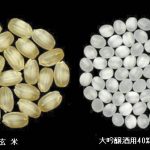 Why does sake rice have the starch in the center, and fat and protein around that? Part of it is just the nature of those strains. But it also has to do with climate and growing conditions. Regions with hot days and cold nights are best for sake rice production, as the cold nights coerce the plant to send the starch to the center of the grains. In “bad years” for rice, seasons being too hot or too cold, too wet or too dry, or when the night and day temperatures had less variance, fewer grains will have a decent shinpaku.
Why does sake rice have the starch in the center, and fat and protein around that? Part of it is just the nature of those strains. But it also has to do with climate and growing conditions. Regions with hot days and cold nights are best for sake rice production, as the cold nights coerce the plant to send the starch to the center of the grains. In “bad years” for rice, seasons being too hot or too cold, too wet or too dry, or when the night and day temperatures had less variance, fewer grains will have a decent shinpaku. Note, too, that one can make decent-to-good sake from regular rice. It takes a good toji and good tools, but just a few of the many examples of table rice from which decent sake is brewed are Koshihikari, Sasanishiki, the illustrious Kame no O. So one can indeed make decent sake from table rice. It’s just easier to do so with real sake rice.
Note, too, that one can make decent-to-good sake from regular rice. It takes a good toji and good tools, but just a few of the many examples of table rice from which decent sake is brewed are Koshihikari, Sasanishiki, the illustrious Kame no O. So one can indeed make decent sake from table rice. It’s just easier to do so with real sake rice. The course will be held from the morning of Tuesday, January 10 to the evening of Saturday, January 14,2017, and will be focused in Tokyo, but with a two- day excursion to the Osaka – Kyoto – Kobe area to visit four sake breweries of various scale. Geared toward professionals, but open to anyone with an interest in sake, this course will begin with the basics, and will provide the environment for a focused, intense, and concerted training period. It will consist of classroom sessions on all things sake-related, followed by relevant tasting sessions, four sake brewery visits, and exposure to countless brands and styles in several settings, both in comparison to other sake, and with food. Participants will stay together at hotels in Tokyo and Osaka. Lectures will take place in a comfortable classroom, and evening meals will be off-site at various sake- related establishments.
The course will be held from the morning of Tuesday, January 10 to the evening of Saturday, January 14,2017, and will be focused in Tokyo, but with a two- day excursion to the Osaka – Kyoto – Kobe area to visit four sake breweries of various scale. Geared toward professionals, but open to anyone with an interest in sake, this course will begin with the basics, and will provide the environment for a focused, intense, and concerted training period. It will consist of classroom sessions on all things sake-related, followed by relevant tasting sessions, four sake brewery visits, and exposure to countless brands and styles in several settings, both in comparison to other sake, and with food. Participants will stay together at hotels in Tokyo and Osaka. Lectures will take place in a comfortable classroom, and evening meals will be off-site at various sake- related establishments.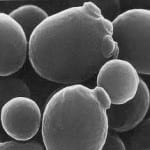 The cost for this five-day educational experience is ¥190,000. This includes all instruction and materials, as well as evening meals with plenty of sake each night. Other meals, transportation to and from as well as within Japan, and hotel are not included in the tuition. To make a reservation or if you have any questions at all, please send an email to John Gauntner at sakeguy@gol.com .
The cost for this five-day educational experience is ¥190,000. This includes all instruction and materials, as well as evening meals with plenty of sake each night. Other meals, transportation to and from as well as within Japan, and hotel are not included in the tuition. To make a reservation or if you have any questions at all, please send an email to John Gauntner at sakeguy@gol.com .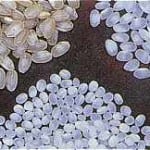 Milling
Milling This section could be expanded to fill several books, at least. But since we do not have that luxury now, let us break it down a bit. There are three main ways of preparing the yeast starter, a few less mainstream but very valid ways, and tons of variations beyond that.
This section could be expanded to fill several books, at least. But since we do not have that luxury now, let us break it down a bit. There are three main ways of preparing the yeast starter, a few less mainstream but very valid ways, and tons of variations beyond that.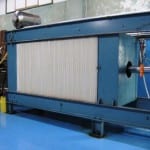 Machine press
Machine press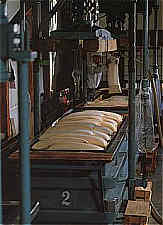 Fune (box press)
Fune (box press)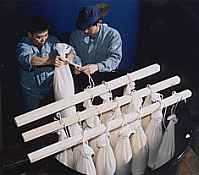 Shizuku
Shizuku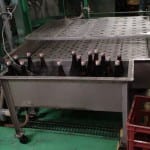 Pasteurization
Pasteurization Aging
Aging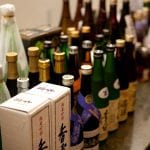 Fond of doing things at the last minute? Then check out the Sake Professional Course to be held in Toronto October 3, 4 and 5. Learn more
Fond of doing things at the last minute? Then check out the Sake Professional Course to be held in Toronto October 3, 4 and 5. Learn more  What is it that makes a sake taste and smell the way it does? What goes into and drives the myriad flavors and aromas we enjoy in today’s sake? We could get really technical. We good go chemical if want to, but it would not likely be pretty.
What is it that makes a sake taste and smell the way it does? What goes into and drives the myriad flavors and aromas we enjoy in today’s sake? We could get really technical. We good go chemical if want to, but it would not likely be pretty. I. Rice = Flavor
I. Rice = Flavor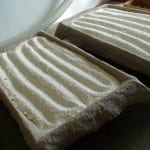 Koji provides enzymes that convert starch to sugar. Just how strong those enzymes are, and at what stage of the brewing process they are most active, will determine how sweet or dry the sake is. If the koji leads to lots of starch-to-sugar conversion early on, that sugar will be readily converted to alcohol leading to a dry sake. If sugar comes along later in the process when the yeast is petering out, it will remain in the sake and lead to sweetness. In truth, this too is more complicated. But therein lies the gist.
Koji provides enzymes that convert starch to sugar. Just how strong those enzymes are, and at what stage of the brewing process they are most active, will determine how sweet or dry the sake is. If the koji leads to lots of starch-to-sugar conversion early on, that sugar will be readily converted to alcohol leading to a dry sake. If sugar comes along later in the process when the yeast is petering out, it will remain in the sake and lead to sweetness. In truth, this too is more complicated. But therein lies the gist.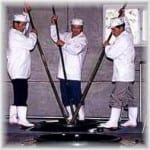

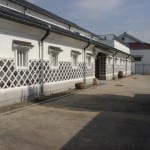
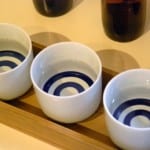
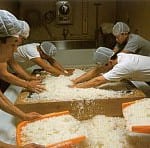

 Yeast is a crucial ingredients in sake.
Yeast is a crucial ingredients in sake. industry focused more on a handful of tried and true yeast strains that have been around for about a century. And before that, everyone depended on their own in-house ambient yeast, which alone could make or break a kura’s reputation.
industry focused more on a handful of tried and true yeast strains that have been around for about a century. And before that, everyone depended on their own in-house ambient yeast, which alone could make or break a kura’s reputation.